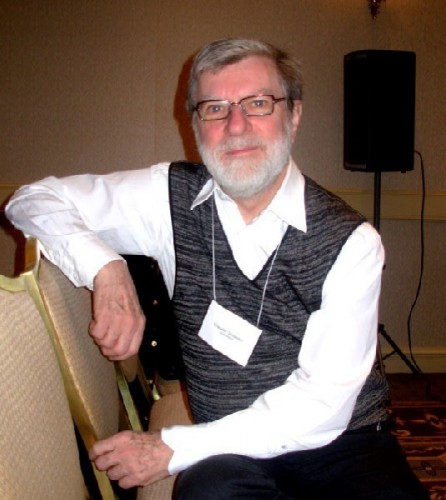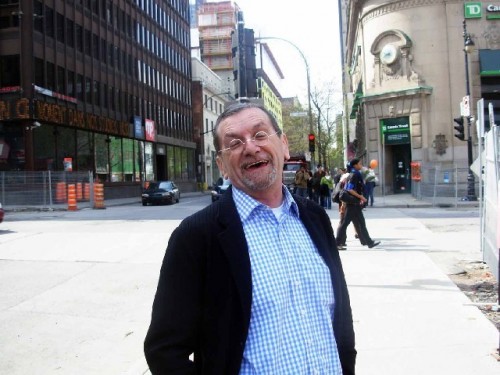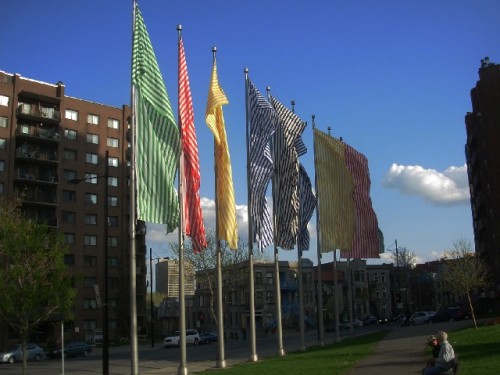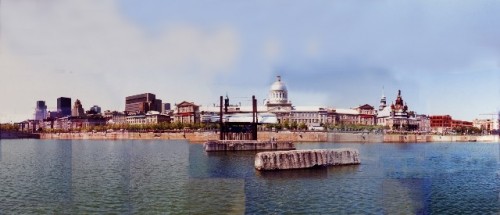Claude Gosselin Curator of La Biennale de Montréal
Starting with Aurora Borealis in 1985
By: Claude Gosselin and Charles Giuliano - Mar 05, 2012
Charles Giuliano Let’s talk about Canadian art and La Biennale de Montréal. How many have you done?
Claude Gosselin Seven. The first was in 1996. The most recent was 2011.
CG Where does Aurora Borealis come in to all of this?
Claude Aurora Borealis was in 1985. I started the 100 Days of Contemporary Art in 1985. The annual event 100 Days lasted until 1994 with different themes and exhibitions. In 1996 the 100 Days became La Biennale de Montréal.
CG Another memorable project early on was Stations.
Claude There was Light in 1986 and we had a half a page in the New York Times for that one. Then Stations in 1989. With curators like Roger Bernard was curating one show and I was curating one next to it. We had two shows on that year.
CG The Montreal gallerist René Blouin was involved with Aurora Borealis.
Claude Yes it was René, Normand Thériault, and myself. We were three curators and we shared the selection of the works. Normand was previously a curator at the Museum of Fine Arts and now he is the head of special sections for the newspaper Le Devoir in Montreal.
CG You have dealt with Canadian art for some twenty five plus years so I am interested to share your insights. In the series of 100 Days exhibitions to what extent was the focus on Canadian art?
Claude There was always a split of 50% Canadian artists and 50% non Canadian artists. So that’s why we had Jenny Holzer, James Turrell and a lot of people from outside Canada. That was always the mandate for 100 Days: 50% Canadian and 50% non Canadian. La Biennale was almost working on the same condition.
CG Was that mandate something you derived or was it a condition for funding?
Claude We have many artists in Canada and very rarely are they shown in the international scene. My goal was to put these Canadian artists with their peers outside of Canada. Then through friendship or connections they might have the chance to have their works seen by other curators and have their work seen outside of Canada. Or even other parts of Canada.
Canada is so big that people from Vancouver or Halifax, some of them came to Montreal to look our shows. So it makes an occasion for connecting with other people. So that was the reason for mixing people from different parts of Canada but also from different parts of the world. I’m the one who did most of the group shows in Montreal. I presented artists from Japan and also from France and Great Britain. I presented Christian Boltanski in 1986 in Montreal. In addition to Boltanski, (Annette) Messager and (Daniel) Buren. All of these artists from France have been presented from France through 100 Days. After that they have been representatives of their own country at the Venice Biennale. Also two artists from Great Britain who were in 100 Days ah, mon Dieu I forget the name, but they also represented their country in the Venice Biennale. (Roy Ascott?) I am getting a bit of Alzheimer’s (laughing) with the names of all these artists whom I have shown.
CG Part of who and what you are is the firm base in Montreal and yet you are a world traveler who sees and selects works for the exhibitions. It’s a kind of micro, Montreal, and macro, global, situation.
Claude I’ve been working with the budget I have. Which is very small. Because of that I’ve never been able to make it global as we talk today. You are competing with the big biennials and the big international shows. That happen in Venice or Sao Paulo or Liverpool. Those big biennials that happen. Anyhow I try to bring to Montreal information that was good for Montreal artists but also good for Canadian artists. It’s also about what’s going on in other parts of the world. The difficulty was to have new projects. Today there are a lot of new biennials. Events in the world. Artists are being solicited more and more. If you want to have the names you have to invest in productions of significant works. That was a problem we were facing. We had to borrow works that already existed rather than working on new productions. But these works never having been seen in Montreal it also worked as new information for people here.
There is a difficulty about the critics. They are very keen on talking about the local artists. But they have difficulty writing about what is going on elsewhere. During the last Biennale which was about Chance included major artists like Jean-Pierre Bertrand from France and other big names from Europe. Nothing has been written about these people. Everything was written about the local artists. This is one of the problems I’m facing. I want to bring information to Montreal about what is going on elsewhere. Artists who people have never seen but who are part of the art history.
I’m talking about our critics and writers. They are not even curious to write about these artists. That’s the Catch-22 of all the works I have done in Montreal and a major disappointment. In 1984 I commissioned a major piece by Buren for Montreal.
CG The flag poles.
Claude Yes. Buren came to Montreal. So we called the critics to meet with the artist and talk about the work. Nobody showed up. It’s ridiculous. After all these years people are saying that the 100 Days was a moment in their life to encounter with these artists. I’m talking about the general public. And the young artists. The disappointment is with the critics and the art reporters. You are the one who has been close to the event who has reported with an open eye. And talked about the other artists. But talking about the local newspapers it has always been a disappointment. That doesn’t mean that the event has had no impact. It has. But I would have liked to have seen the critics be a little more curious. Taking the opportunity of seeing a Messager in Montreal.
CG I would like to thank you and René for the generosity of inviting me to Canada on so many occasions to see the exhibitions and to write about the work. It has provided an intensive exposure to contemporary Canadian art for which I am very grateful. Some of the projects have been truly wonderful and memorable.
Not necessarily for the work but one of my favorite experiences was when you installed an exhibition in the vast space of a former Molson’s brewery. That was one of the early experiences of viewing works of art in a raw, industrial setting.
As a curator you have been a gypsy with no fixed real estate or museum. An exception was the 2000 Biennale when you had a rented space on Sherbrooke Street. You have no real estate so that means you are constantly reinventing yourself. In addition to curating the exhibitions you have to raise money and find a venue to install the project. It seems like a lot of balls to keep in the air at one time.
Claude (Laughing) Yes, to say the least. I always put the money I had into the output and not working on the long term by building an administration which would continue when I’m not there anymore. If I had worked on this there would have been no money for the project itself.
As a gypsy, you’re right. I’m working day to day. With what I have today and then I put everything into the project. Then I try to respond to what I feel around me. This may be a lack, I must say, after all these years, at the end, because I’m retreating now. At the end of working for a next Biennale.
That might be the lack of my work because I didn’t spend enough time building a sustainable administration. For the future. In terms of the administration. I must say, we are at the day one of the 100 Days of Contemporary Art or La Biennale. So, that is what I see now. Because there is no money ensured by the government or the Council for the Arts towards La Biennale. So it is difficult to find a new person to be in charge of these events for Montreal.
We’re working on this now with the board of directors. Some people are fed up with my presence. Sometimes my telling them my impressions on their own administration. And their lack of vision. So they have been recently, well ah, I don’t want to use the word insulted, but I had a difficult meeting where people said, well, it’s time for you to go. (laughs) So now I am just trying to put an end to my activities with La Biennale.
I don’t want to close Centre international d'art contemporain de Montréal (CIAC). It’s a nice tool to work with and invite freelance curators. I have a good board of directors so CIAC will be moving toward a new kind of activities. One of those is to promote artists abroad.
CG Am I hearing that there won’t be another Biennial?
Claude We are in a moment that we have to decide about the next one. The Council for the Arts in Quebec is strongly believing in a Biennial. But it has to be done under someone else. It has to find a new spirit. We have an application for a Biennial in 2013 but we are waiting for the results of our calls. These will come in April with the new fiscal year of the government. If the applications are successful from the Council for the Arts in Montreal, in Quebec and in Ottowa, if the money is there, we will have a Biennial in 2013. But there is a kind of decision that these councils are working together on shall we pass on 2013 and then work on a new Biennial for Montreal and have it, the next one, in 2015?
I have explained to them that most of the Biennials around the world are under the auspices of museums, cities or governments. In Montreal we are working with North American ideas for culture. It’s a mix of private and public funds. In the States it’s almost everything private funding. In Canada it’s a mixture of private and public. For our events 75% is from government. With 25% from private funding.
Those Biennials around the world because they are working with a museum they have a venue. They have a staff. They have equipment. That is a big part of the cost of a Biennial. The little money that we have is mostly to rent a space and have a new staff. We have very few equipment. It is difficult to make a Biennial to compete with the other ones. We have to redefine the Biennial and what I am proposing for Montreal is that the Biennial should be a Biennial of new works. Investing in productions of new works with artists. Maybe less artists. Not competing in terms of the amount of artists. In terms of having good names of artists and new productions from each of them.
CG What is an average budget for a Biennial?
Claude In terms of Canadian money it doesn’t compare with the Americans. It’s about $1.2 to $1.5 million. For two years it’s not that much. For what goes to the artist for the production it’s 60% of that money. The other money is for the administration and the communication. The communication is 25% and administration is 15%.
CG Who pays to bring in and house the artists?
Claude For very large exhibitions and biennials very often it’s the government of the artist that covers the cost of traveling and the works. For the last one La Bienanale paid for everything. The cost of traveling the works. Because we had many works. Just for the transportation of the art works was $90,000. Plus the artists coming to Montreal and their stay for seven days. For the installation of the works. Paying for the venue and equipment. People working on building the walls. It’s another $125,000.
CG The last Biennale we wanted to come but by the time we got organized it was over. It didn’t seem to be up for very long.
Claude The last three Biennales were up for only a month. The whole month of May. It’s because we have no permanent venue or staff. Because we had to borrow the venue we had to pay rent. Between one month and three months makes a difference. We have volunteers but you need a personal security staff. Also for communitcation. Being in the paper. Buying advertising. One month vs. three months that’s a big difference. Working for one month is kind of a festival for the arts. In fact Montreal is a city of festivals. They generally last ten days and we’re lasting 30 days. So it’s three times the festivals of other disciplines in the arts. We get about 20,000 to 25,000 attendance for a month. It’s very good but the problem is that Montreal being a city of festivals and having a large public for a jazz festival or film festival because they have very large public events on the streets they have a lot of attendance. Our government tends to compare that to the visual arts.
In 2009 we had a thousand people at the opening. A journalist wrote in the paper that this was not even a small night at the jazz festival. (laughs)






